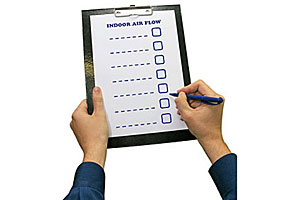
|
The purpose of an A/C “preventive maintenance” or “tune-up” call is to clean up a system after a year of wear and tear, and to make sure it is working at peak efficiency.
With modern equipment, there is little need to physically adjust and lubricate, so the rest of the job should be spent on diagnostics. Unfortunately, many technicians still are trying to perform obsolete tasks, which often do more harm than good.
With A/C and heat-pump systems, one of the most critical but most overlooked things to check is the indoor airflow. My experience has shown that few technicians even carry a tool to diagnose airflow problems.
When the airflow across the indoor coil is too high, water droplets are blown off the coil into the ductwork, creating mold (an air-quality problem). On the other hand, too-little indoor air or air that is misdirected across the coil drastically cuts into system efficiency. This should be checked on every visit and requires technicians to purchase and use a static-pressure gauge.
Of course, keeping air filters changed on a regular basis is usually enough to ensure proper airflow. But when customers or construction crews run systems without air filters, the coils quickly clog up and start cutting the efficiency. You’ll also find that people mess with the proper air balance in buildings by closing off diffuser grills.
In addition, attic ductwork may be crushed or even broken open by people working in the area; and most of these conditions usually can be determined by taking just a couple quick static pressure readings, one across the air handler and another across the indoor coil.
To take static pressure readings, you drill two 1/4-in. holes, one on each side of the indoor coil, making sure you are not drilling into a refrigerant or electrical circuit. Next, check the pressure between the holes with a static pressure gauge. What should it read? If you look at the specifications for the coil, you will see the static pressure across it gives a fairly accurate indication of the total airflow when the coil is clean.
Typically, on a residential system this amounts to a pressure drop of less than 0.4 in. (visit www.gormanindustries.com/RCFN.pdf for an example). After the reading is taken, the holes should be covered by two small pieces of adhesive foil tape. A higher reading, of course, indicates either too much airflow or a dirty coil, while a low reading indicates insufficient airflow.
Another reading should be taken the same way between the return to the air handler or furnace and at the ductwork leaving it. On residential HVAC systems, the maximum pressure rise should not exceed about 0.7 in. For an example, check out Page 8 at http://goo.gl/Vosov4.
Here, a lower reading usually indicates higher airflow, while a higher reading indicates lower airflow. A very low reading could indicate there is a break in the ductwork or that the airflow is just too high and water is likely being blown off the coil, meaning the system needs balancing. On the other hand, a very high reading indicates insufficient ductwork or a restriction in the air ducts. And of course, the drilled holes should be covered before leaving the job.
This is a very technical business. Make sure the work being done is in accordance with technical specifications.



